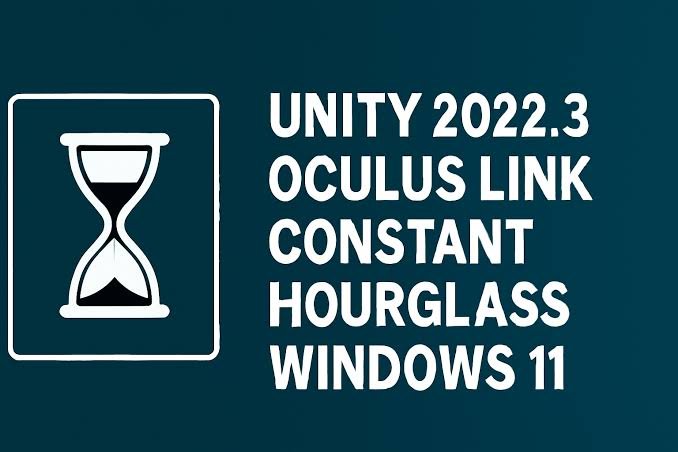When using Unity 2022.3 in combination with Oculus Link on Windows 11, some users have encountered an irritating issue: the constant hourglass. This persistent loading symbol can disrupt the workflow and hinder your VR development experience. This article will walk you through understanding this problem and provide actionable solutions to resolve it.
What Is the Unity 2022.3 Oculus Link Constant Hourglass Issue?
The Unity 2022.3 Oculus Link constant hourglass problem occurs when the Oculus Link application is connected to Unity, but the system fails to proceed beyond the loading stage. Users typically experience an unresponsive Unity interface, where the mouse cursor continuously shows the hourglass icon without any progress.
This issue is often linked to performance problems between Windows 11, Unity, and the Oculus Link application, impacting the workflow. While this problem is frustrating, understanding the potential causes is the first step toward solving it.
Why Does the Hourglass Problem Happen?
Before diving into solutions, it’s crucial to understand why the Unity 2022.3 Oculus Link constant hourglass Windows 11 problem occurs. There are several contributing factors, including:
- Outdated drivers: Both Oculus and GPU drivers may not be up to date, leading to compatibility issues.
- Unity settings: Incorrect configurations or settings in Unity might cause conflicts with Oculus Link.
- Windows 11 performance issues: Compatibility issues or performance bottlenecks in the Windows 11 OS could hinder the proper functioning of Oculus Link.
- Background processes: Excessive background processes or insufficient system resources could affect the VR setup.
Now that we have a clearer idea of why this issue occurs, let’s move on to troubleshooting.
Troubleshooting Steps to Fix Unity 2022.3 Oculus Link Constant Hourglass Issue
1. Update Oculus Link Software
First, make sure that you’re using the latest version of Oculus Link. An outdated Oculus app can cause compatibility problems with Unity. Open the Oculus app, go to Settings, and check for any available updates. Keeping the software up to date ensures smoother compatibility with Unity 2022.3 and Windows 11.
2. Update GPU and Oculus Drivers
Outdated drivers are often at the root of performance issues. To eliminate this as a possible cause, update both your GPU drivers and Oculus drivers.
- GPU drivers: Visit the official website of your GPU manufacturer (NVIDIA, AMD, or Intel) to download the latest drivers.
- Oculus drivers: Open the Oculus app and ensure that it is updated to the latest version.
3. Verify Unity 2022.3 Settings
Improper Unity settings could be causing the constant hourglass issue. Here’s what you can do:
- Switch to Direct Mode: In Unity, go to the XR Settings and ensure that Direct Mode is enabled. This will allow Unity to directly control the Oculus Link, bypassing any unnecessary processes.
- Disable Vulkan: If Vulkan is enabled in Unity, switch to OpenGL or DirectX instead. Vulkan might not play well with Oculus Link.
- Optimize your Unity project settings: Ensure that your project is set up correctly for VR development, and that the Oculus integration is properly configured.
4. Check Windows 11 Performance
Since the issue occurs specifically on Windows 11, ensure that your system is optimized for VR applications. Here are some things to check:
- Update Windows: Make sure that your Windows 11 OS is up to date. Go to Settings > Update & Security > Windows Update and install any pending updates.
- Disable unnecessary background processes: Open the Task Manager and close any unnecessary processes running in the background that could be eating up system resources.
- Power Settings: Ensure that your power settings are configured for maximum performance. Go to Settings > System > Power & Battery and select the High performance option.
5. Reconnect Oculus Link and Restart Unity
If all else fails, try reconnecting the Oculus Link cable and restarting both Unity and the Oculus app. This basic troubleshooting step may resolve the issue by re-establishing a clean connection between the Oculus headset and Unity.
6. Reinstall Oculus and Unity
In rare cases, corrupted installations of either Unity or the Oculus app might be causing the constant hourglass problem. Try uninstalling and reinstalling both applications. Make sure to back up your projects before proceeding.
Additional Tips for Optimizing Oculus Link Performance in Unity 2022.3
- Reduce the graphical load: Lower the resolution settings or reduce the complexity of the scenes you are working on to improve performance.
- Disable Anti-aliasing: Disabling anti-aliasing in Unity settings can reduce graphical overhead, which might help improve stability.
- Use USB 3.0/3.1 cables: Ensure you’re using a high-quality USB 3.0 or 3.1 cable for Oculus Link, as this ensures better performance and reduces the chances of connectivity issues.
Conclusion
Experiencing the Unity 2022.3 Oculus Link constant hourglass Windows 11 issue can be frustrating, but it is solvable with the right steps. Make sure to keep your software and drivers up to date, optimize your system settings, and tweak Unity configurations for smoother performance. By following the troubleshooting steps outlined in this article, you can get back to developing VR applications without interruptions.
If the issue persists even after these steps, it might be worth checking Unity and Oculus forums for more specific solutions or updates from the community.
FAQs
- What is Oculus Link?
Oculus Link allows you to connect your Oculus Quest or Quest 2 to a PC to play PC VR games, including those developed in Unity. - How do I fix Unity 2022.3 Oculus Link constant hourglass on Windows 11?
Follow the troubleshooting steps, including updating drivers, adjusting Unity settings, and optimizing Windows 11 performance. - Does Oculus Link work with Windows 11?
Yes, Oculus Link works with Windows 11, but compatibility issues may arise if drivers or software are outdated. - Why does my Unity editor freeze when using Oculus Link?
This could be caused by performance issues or incorrect Unity configurations. Check settings and update drivers. - How can I improve Oculus Link performance in Unity?
Reduce graphical complexity in Unity, use USB 3.0/3.1 cables, and disable unnecessary background processes.



